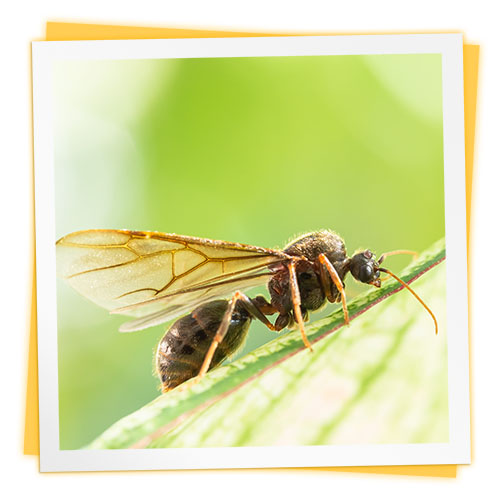This page may contain affiliate links.
Read our disclosure and privacy policy here.
This fascinating journey into the world of ant keeping begins with learning how to catch a queen ant! Ants, like termites, bees, and wasps, live in a colony structure with at least one queen laying all the eggs which eventually hatch into all the members of the colony. So how do you go about catching one? This article will teach you all you need to know about finding, and catching, your very own queen ant.
Table of Contents
6 Easy Ways to Catch a Queen Ant Safely
Useful Lesson Opportunities From This Activity
- Science and Nature
- Observation and attention to detail – learning to tell the difference between queen ants and worker ants.
- Learning about ant behavior, and characterizing it.
- Life Skills
- Patience! It can take time to find a queen ant, sometimes several days of searching.
- Perseverance! For the same reasons as above.
- Always be prepared! Keeping a small container on you at all times when you leave the house will make sure that you are prepared for that chance unexpected encounter with a queen ant.
List of Materials
- Paint Brush (approx 1.5cm)
- Small Plastic Container
- Piece of paper
Note: Once you catch a queen ant, you’ll need to read our article on how to create a test tube founding chamber for her in order to start a colony.
The Key To Finding An Ant Queen Is Patience And Perseverance
When I first got into the ant keeping hobby, I used to get pretty frustrated that I could not find any queen ants. I searched daily all over my neighborhood without success. I watched videos that made it look so easy, and yet try as I might, I could not find any.
The key to catch your very first queen ant is patience. That was not something I was really good at! But eventually, I did indeed find one, and then another, and then more and more. One day it was literally raining queen ants!
So, how do you find and catch one of your own? There are a lot of great videos and guides online that show a range of methods. I’ve tried almost all if not all of them, and I’m going to list here the top five ways I’ve found work the best to find queen ants.
I’m also going to share with you the best method I’ve come up with to actually catch a queen ant safely once you’ve found one.

Did You Know?
Did You Know?
Download Printables
THE BEST TIME TO FIND QUEEN ANTS
Although you can find queen ants anytime during the warmer months of the year, you are most likely to find them on a warm day or evening after a good summer rainfall.

What does a queen ant look like?
While this guide on what a queen and looks like goes into more detail, the easiest way to know if an ant on the ground is a queen is by looking at the ant’s behavior, movement, and size.
You’ll be looking for a slow moving, larger ant that is taking the time to investigate various nooks and crannies in on the ground, searching for a suitable place to start her colony. A queen ant will usually have a larger abdomen and thorax than the workers of her species, and occasionally may also still have her wings. Usually queen ants will tear off their wings after their nuptial flight This is an adaptation that allows them to be less conspicuous to predators, but some queen ants will not do this.
Queen ants search for an ideal location to found a new colony.
The best time to find queen ants
The future queens (called alates) of the various species of ants will emerge from their colony nests and have nuptial flights at certain times of year, between February and October in North America. The most common time to find queen ants are in the summer months, immediately following a good rainfall on a warm and humid day. Trying to find a queen ant in a hot, dry spell is unlikely, although it is definitely possible with luck and perseverance. You can learn more about alates and the ant reproductive cycle in this article.
You will also be able to see some telltale signs of an impending nuptial flight. When you see these signs, then you can plan to go out later that day or the following morning to search for queen ants.
So now that we know the best time to find new queen ants, the next question is ‘where do we look?’.
Male and female alates prepare for their nuptial flight.
The best places to find queen ants
If you live downtown or in a heavily urbanized area, I’ve found it is harder to locate a variety of queen ants. You will definitely find some with time, but it’s much, much easier to find a good variety of species of queen ants in suburban and rural areas. When searching at the right time, such as after a heavy summer rainfall, you may find queen ants literally falling from the sky!
I recommend looking on walkways , the edges of parks and fields, driveways, dirt roads, trails, etc. Look for relatively flat areas when it would be easy to spot a slower moving and generally larger ant. Having a good contrast between the color of the ground and the color of the ant makes it easier to spot them, which is why most of the ants that I catch are simply walking on the sidewalk. They are so much easier to see!
Just talking a leisurely stroll and keeping your eyes on the ground – while being aware of your surroundings! – should be sufficient to spot the more common larger queen ants in your area. For large ant queens like Formica Fusca or Camponotus species which are common in my area (Ottawa, Canada), I can even spot them as I’m taking a bike ride! There are some queen ants however like Thief Ants or Rover Ants that are only a few millilitres in size, and you might not notice them unless you stop for a moment and scan the ground carefully.
Some people recommend looking under rocks and logs, because new queen ants will be actively looking for hiding spots or new colony sites and may find rocks and logs look like safe and promising nesting sites. However I’ve found to be very unlikely to find queen ants this way. Most likely you will find and disturb an existing colony.
If you do find a colony, take note in your ant journal of the location of the colony you have found and try to take a quick picture of the ants before replacing the rock or log carefully. This information will be useful in the future in case you need to perform advanced procedures with your colony like a brood boost, or if you find a parasitic queen ant that requires host workers.
You can however use the tendency new queen ants have to seek out a safe colony location to create a queen ant trap! But if you are just starting out with ant keeping, the best way is to simply find a queen ant that has landed after her nuptial flight and is searching for a new colony site.
How to Actually Catch a Queen Ant
Hooray! You’ve found a queen ant! Now comes the tricky part. How do you catch her safely before she gets away? Depending on the species, catching a queen ant can be a frantic experience. Trying to get your container out, keeping an eye on her, trying to prevent her from escaping into the grass or a crack in the sidewalk, and trying to be careful not to accidentally hurt her – the first queen ant you attempt to catch is an exciting experience!
Being prepared with the proper tools and containers can be the difference between successfully catching your first queen ant, or accidentally losing her or harming her in the process. Here are a few methods that I’ve used in the past that have worked well for me.
The Tube Container Method
This is the simplest method, but also the most difficult to get right for those who are new to the hobby. Basically the idea is that you would place your tube container like a plastic test tube (do not use glass as it could shatter) or sample tube in front of the queen and, and try to guide her into it with your other hand.
For some species, this works wonderfully, however most of the time you will end up hopping around back and forth trying to convince the queen that walking into this tube is a good idea for her. As you move the tube around and try to keep up with the queen, you have a greater chance of accidentally placing the edge of the tube right on top of her, injuring her badly.
Success with this method requires you to stay calm and have a steady hand. It will take several tries before the queen ant walks into your container. I do not generally recommend this method for beginners unless you really have no other choice.
The Paintbrush Method
This method still uses a tube container like a plastic test tube, but instead of waiting for the queen ant to just walk into the container, you would ‘flick’ her in gently using a soft bristle paint brush.
This method works especially well with smaller ant species like Thief Ants. They are so small that they can even slip beneath the edge of the test tube when you are trying to catch them on a rough surface like a sidewalk. A soft-bristle paint brush is very gentle on the ants and will not harm them. To use this method, just place the container next to the queen ant and use the paint brush to flick her into the container.
The Paper Method
This method requires a little more manual dexterity, but can work well on larger ant species or those that you are having trouble catching with the above methods.
With this method, you simply lay a piece of paper down in front of the queen ant. Because of the size of the paper, even if she tries to avoid it, she will likely end up crawling onto it without any real effort on your part. Once she is on the paper, you can then lift if up quickly and bend the paper to make it into a slide. Place your container at the bottom, and shake the paper gently or push the queen and with your finger to get her to slide down the paper and into your container.
You need to be careful with this method as you could accidentally shake the paper a bit too much and flick the queen off the paper completely and lose her.
The Tissue Method
This method is really a desperate move, but works if you have nothing else. Similar to the paper method, you would place piece of tissue in front of the queen ant. Once she crawls onto it, you would carefully and very gently fold up the tissue so that the queen ant is captured inside it. Make sure to fold all the edges in so that she cannot escape. The tissue will gently hold her in place while you rush to get a container to put her in.
I’ve used this method a few times, when I found a queen ant and had no containers at all on me to catch her with. But this is a very last resort method and you need to be exceedingly careful not to crush her. Don’t just place the tissue in your pocket! If you use this method, the very next step must be for you to quickly find a more suitable container to hold her in.
The Poop Bag Method
So I was walking my dog the other day and spotted a queen ant I wanted to capture. Unfortunately, I had absolutely nothing to hold her in. I did however have some poop bags in my pocket. So I held the bag on the ground and pressed down the edges in front of the queen ant. When she finally walked into the bag, I puffed up the bag to get some air into it, and tied up the end of the bag to make it like a balloon. This method works well if you are like me and can almost always find a poop bag in one of your pockets!
The Ant Vacuum Method
The mouth vacuum method can be a really effective method to catch very small and delicate ants, or if you get lucky enough that you find several small to medium sized queen ants in the same place and you are trying to catch all of them quickly.
You’ll need the Ant Vacuum for this method, available soon in our store. Simply insert a sample container into the vacuum, put the suction hose into your mouth, and place the intake hose next to the ant you want to capture. When the queen ant is next to the intake hose, do a short and strong suction and it will suck the queen ant right into the sample container. You can also use this to capture small delicate worker ants to examine under a microscope.

DISCUSSION
DISCUSSION
DISCUSSION
FOLLOW-UP TOPICS
Science Topics
Colony
Alate
Adaptation

There’s a lot to explore right where we are, in our own neighborhoods and backyards! Join us while we get off the couch and explore the everyday wonders of nature, science, space, engineering, art, and anything else we stumble upon during on our adventures.



